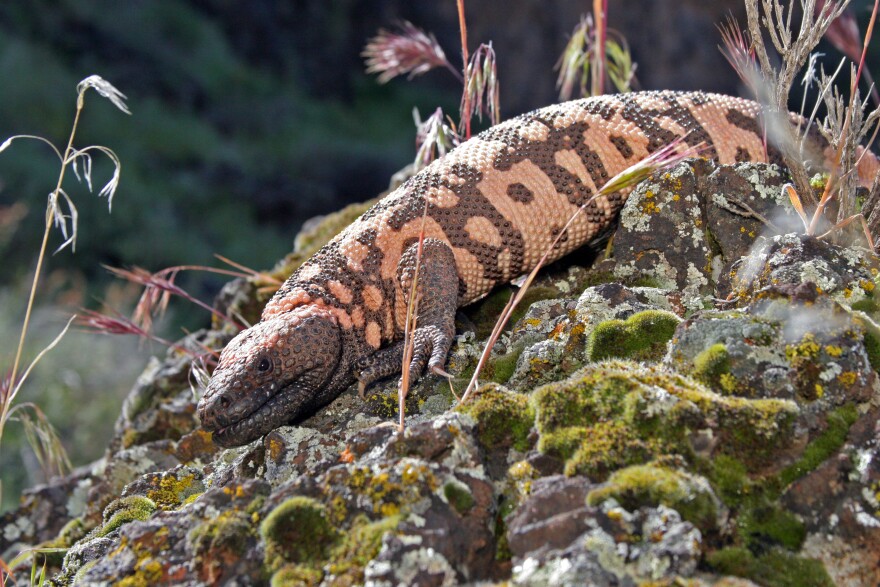The Gila monster is Utah’s state reptile. But you’ll only find them in the southwest corner of the state near St. George.
For now, anyway.
By the end of the century, the colorful desert lizard could expand its range from the West Desert and Colorado Plateau to the Wasatch Front. That’s according to research, published last October, from the U.S. Geological Survey.
“Their potential climate niche might increase up to 60% more of the state,” said Michelle Jeffries, a USGS biologist who worked on the study. “Most of the species are predicted to increase in niche space across Utah.”

The study mapped 130 lizards and snakes in the western U.S., Canada and Mexico based on each species’ climate niche — the set of seasonal temperatures and precipitation patterns that allow it to thrive. Following a likely climate scenario with continued greenhouse gas emissions and higher temperatures, the majority of the 96 reptiles it looked at within Utah are expected to expand their potential range by 2070-2100.
An interactive USGS database shows that reptiles with the largest potential niche increase in Utah include the Smith’s black-headed snake, eastern collared lizard and the coachwhip snake. The state could also welcome new species — 12 lizards and 15 snakes — for the first time. That group includes the Texas horned lizard, Mojave fringe-toed lizard and Texas banded gecko.
Others might not be so lucky. A handful of reptiles are expected to have their Utah habitat range reduced, such as the North American racer snake and pygmy short-horned lizard.
It’s unclear how these shifts might play out in reality, though.
“There's a lot of unknowns,” Jeffries said. “But I think our study really opens the door to starting to ask more direct questions about some of these unknowns.”
As previously unacquainted species come into contact, it could change predator-prey dynamics and spark fresh competition for everything from rock piles to shade. New neighbors might vie for the same insects as long-time residents or be an additional food source for local carnivores.
“It's possible in 50 years from now, their ranges might overlap for the first time ever, or the first time in a very long time,” Jeffries said. “And we don't know what that might mean.”
Migrating reptiles would also impact the places they leave behind. Species that remain may see a surplus of food because there’s less competition, or may have less on their menu because they ate the lizard that left.
These are the types of uncertainties that scientists will be watching for, said Alyssa Hoekstra, native herpetology coordinator with the Utah Division of Wildlife Resources. That’s especially true for the most dramatic potential movements, like the one the study predicts for the Gila monster.
“A lot of us were kind of shocked to see the expansion of their habitat,” Hoekstra said. “In some ways, that's exciting,” but it doesn’t mean people living in Moab or Tooele should expect one to show up at their front door anytime soon.
Gila monsters spend most of their time in a burrow or under a rock, so they would be slow to disperse across hundreds of miles of new territory — if they could do it at all.
“I really do think it would be low potential for them to do it naturally on their own,” Hoekstra said. “But, you never know.”
That illustrates an important caveat to this research, Jeffries said. Even if the temperature and precipitation levels in a potential new home would fit what a reptile wants, they would still need to get there.
They’re likely to face natural barriers, such as deep canyons and tall mountains, as well as highways and other human-created boundaries.
“It does seem like there will be ecological space for these species to move into,” Jeffries said. “We just have to help them get there, potentially.”
That’s where wildlife agencies could step in and give the migrants a boost by building wildlife corridors and road crossings.
It’s possible states could also collaborate to physically move reptiles from a space where they’re losing climate niche to one that they’ve gained in Utah. But those decisions may not happen for decades, Hoekstra said.
“There's always risk with that, too,” she said. “Talking about it sounds very promising, but then the result could be that they don't adapt very well to being moved.”
Before any of those steps, however, scientists need a better idea of how many reptiles are already here and where they live. Utah doesn’t have much baseline data about its snake and lizard populations, Hoekstra said, and that’s true in other states as well. It can be hard to do the time-consuming species surveys and other hands-on research required to answer those questions because of limited funding at state agencies.
“Sometimes we operate kind of in the dark,” Hoekstra said. “So, the more information we have, the better we feel about our decisions.”
Datasets like the USGS study lend a hand, she said, by helping scientists narrow their focus and prioritize which questions they should try to answer first.






